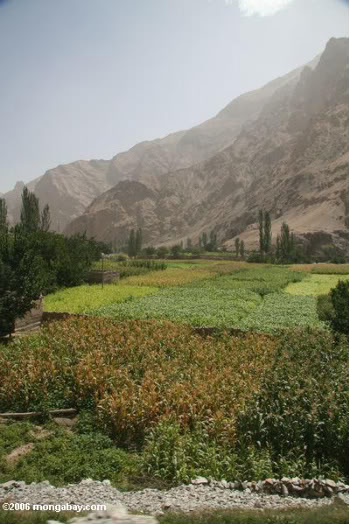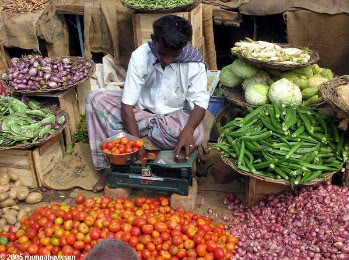|
|
While the use of synthetic fertilizer has greatly increased agricultural production globally—helping to feed a global population that is not slowing down—it has brought with it high environmental costs. Fertilizer runoff has polluted many coastal regions creating ‘dead zones’ where the ocean is starved of oxygen by the influx of nitrogen. Synthetic fertilizers have also polluted the air with ammonia, and sent emissions of nitrous oxide into the atmosphere, contributing to global warming.
Due to its negative affect on the environment, synthetic fertilizer have acquired a bad name in certain circles, leading some researchers to call for reduction in the use of synthetic fertilizers. However, a new study in Science urges a case-by-case approach to synthetic fertilizer use.
 Corn fields in China: a new study finds that Chinese farmers are using far more synthetic fertilizer than is necessary. Photo by: Rhett A. Butler. |
“Some parts of the world, including much of China, use far too much fertilizer,” lead author and biology professor at Stanford University, Peter Vitousek says. “But in sub-Saharan Africa, where 250 million people remain chronically malnourished, nitrogen, phosphorus and other nutrient inputs are inadequate to maintain soil fertility.”
The authors found that farmers in north Chinas use approximately 525 pounds of fertilizer per acre (588 kilograms per hectare) every year. Over a third of this—200 pounds—ends up polluting the environment. Farmers could cut their use of fertilizer in half without a reduction in crop yields, according to the researchers.
The manufacture of synthetic fertilizer is subsidized by the Chinese government, whose own statistics show an increase of nitrogen fertilizer by 271 percent since the late 70s.
Sub-Saharan Africa is another story entirely. A 2004 study in western Kenya found that farmers used 6 pounds of fertilizer per acre (7 kilograms per hectare), less than two percent that of Chinese farmers.
“Africa is a totally different situation than China,” said Sanchez, director of tropical agriculture at the Earth Institute at Columbia University. “Unlike most regions of the world, crop yields have not increased substantially in sub-Saharan Africa. Nitrogen inputs are inadequate to maintain soil fertility and to feed people. So it’s not a matter of nutrient pollution but nutrient depletion.”
The authors recommend that African farmers be provided with subsidies to purchase fertilizer and better quality seed in order to improve agricultural productivity. This may prove costly as fertilizer has skyrocketed in price recenlty: it rose 200 percent in 2007. A trend that has been attributed to rising demand for fertilizer due to biofuel production.
“In 2005, Malawi was facing a serious food shortage,” says Pedro Sanchez director of tropical agriculture at the Earth Institute at Columbia University. “Then the government began subsidizing fertilizer and corn seeds. In just four years production tripled, and Malawi actually became an exporter of corn.”
The change in Malawi amounted to a ‘green revolution’: a process of agricultural reform begun in the 40’s in Mexico that has led to significant gains in agricultural productivity due to fertilizer, better seeds, irrigation, and pesticides.
However, there are critics of the ‘green revolution’, who point to the environmental and health impacts of depending on synthetic fertilizer and pesticides. Places like India, which started its ‘green revolution’ in 60’s, have seen increased cancer rates (linked directly to chemical-use), diminished water quality and quantity.
 Food-seller in India: while the ‘green revolution’ in India has increased crop yields significantly it has also lead to environmental and health problems. Photo by: Rhett A. Butler. |
The authors argue that if managed smartly it doesn’t have to be that way. “Avoiding the misery of hunger is and should be a global human priority,” said co-author G. Philip Robertson, a professor of crop and soil sciences at Michigan State University. “But we should also find ways to do this without sacrificing other key aspects of human welfare, among them a clean environment. It doesn’t have to be an either/or choice.”
Yet, even places which have drastically—and successfully—scaled back the use of synthetic fertilizers, pollution still remains a major issue. For example despite U.S. farmers cutting back on nitrogen fertilizer the massive dead zone in the Gulf of Mexico persists.
“The problem of mitigation of excess nitrogen loss to waters is not easily resolved,” said co-author Penny Johnes, director of the Aquatic Environments Research Centre at the University of Reading, U.K. “Society may have to face some difficult decisions about modifying food production practices if real and ecologically significant reductions in nitrogen loss to waters are to be achieved.”
Related articles
Rich countries buy up agricultural land in poor countries

(05/26/2009) Over two-and-half million hectares in the Democratic Republic of the Congo; half a million hectares in Tanzania; and a quarter of a million hectares in Libya: these figures represent just some of the recent international land deals where wealthy countries buy up land in poorer nations for food, and sometimes biofuel, production. The controversial trend has sparked a recent report from the International Food Policy Research Institute (IFPRI) highlighting what nations have to gain—and lose—from participating in such deals.
Global warming will hit corn yields, costing US over a billion dollars annually
(04/10/2009) Corn is the staple crop of the US. Its annual yield is more than twice that of any other American crop, covering an astounding 125,000 square miles. However, this behemoth crop is currently threatened. A new analysis by Environment America, shows that lower yields of corn due to global warming will cost farmers 1.4 billion every year.
Loss of genetic diversity hurts agriculture

(03/23/2009) Agriculture has long been dependent on the ability of plant species to adapt to varying environmental conditions — without this diversity agriculture development would not have been possible. But human activities are putting this diversity at risk through habitat destruction and introduction of alien species, especially in parts of the world where such diversity is particularly critical: tropical developing countries. This threat has spurred increased efforts to find and conserve plants with special traits adapted to the marginal farming systems of tropical smallholders.